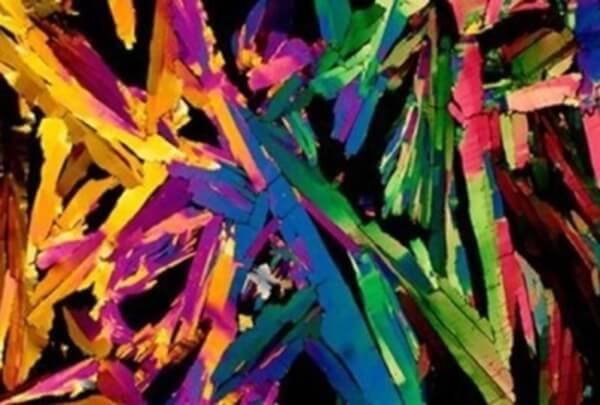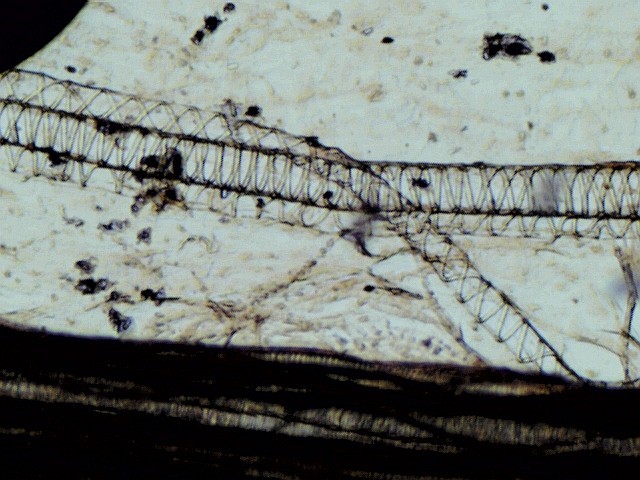Pineapple Under Microscope
Raphides (pronounced /ˈræfɪˌdiz/, singular raphide /ˈreɪfʌɪd/ or raphis) are needle-shaped crystals of calcium oxalate monohydrate (prismaticmonoclinic crystals) or calcium carbonate as aragonite (dipyramidalorthorhombic crystals), found in more than 200 families of plants.Both ends are needle-like, but raphides tend to be blunt at one end and sharp at the other.
Calcium oxalate in plants[edit]
The Chrono is the best place to buy weed online in Canada. Fast shipping, accurate user reviews and great prices make The Chrono your one-stop-shop for great product. Why your tongue burns when you eat pineapple revealed (and all you need to stop the pesky enzyme is some salty water). Kenya Moore cries as faltering marriage comes under intense microscope.
Many plants accumulate calcium oxalate crystals in response to surplus calcium, which is found throughout the natural environment. The crystals are produced in an intriguing variety of shapes. The crystal morphology depends on the taxonomic group of the plant. In one study of over 100 species, it was found that calcium oxalate accounted for 6.3% of plant dry weight.[1] Crystal morphology and the distribution of raphides (in roots or leaves or tubers etc.) is similar in some taxa but different in others leaving possible opportunities for plant key characteristics and systematic identification; mucilage in raphide containing cells makes light microscopy difficult, though. Little is known about the mechanisms of sequestration or indeed the reason for accumulation of raphides but it is most likely as a defense mechanism against herbivory. It has also been suggested that in some cases raphides may help form plant skeletal structure. Raphides typically occur in parenchyma cells in aerial organs especially the leaves, and are generally confined to the mesophyll. As the leaf area increases, so does the number of raphides, the process starting in even young leaves. The first indications that the cell will contain crystals is shown when the cells enlarge with a larger nucleus.[2]

Raphides are found in specialized plant cells or crystal chambers called idioblasts.[3] Electron micrographs have shown that raphide needle crystals are normally four sided or H-shaped (with a groove down both sides) or with a hexagonal cross section and some are barbed. Wattendorf (1976) suggested that all circular sectioned raphides, as visible in a light microscope, are probably hexagonal in cross section[4] The hexagonal crystals reported by Wattendorf in Agave americana were apparently calcium oxalate.[5]
Microscopy using polarized light shows bright opalescence with raphides.
Plants like Tradescantia pallida also accumulate calcium oxalate crystals in response to heavy metals stress.
Harmful effects[edit]
Raphides can produce severe toxic reactions by facilitating the passage of toxin through the herbivore's skin when the tissue containing the raphides also contains toxins. The lethal dose to mice is around 15 mg/kg.[6] Raphides seem to be a defense mechanism against plant predators,[7] as they are likely to tear and harm the soft tissues of the throat or esophagus of a plant predator chewing on the plant's leaves.[8][9] The venomous process is in two stages: mechanical pricking and injection of harmful protease. Typically ingestion of plants containing raphides, like those common in certain houseplants, can cause immediate numbing followed shortly by painful edema, vesicle formation and dysphagia accompanied by painful stinging and burning to the mouth and throat with symptoms occurring for up to two weeks.[10] Airway assessment and management are of the highest priority, as are extensive irrigation and analgesics in eye exposure.
Raphides cannot normally be destroyed by boiling; that requires an acidic environment or chemical solvents like ether. Plants containing large amounts of raphides are generally acrid and unpalatable. However, it is not always possible to detect the presence of raphides through taste alone. In some tubers such as Indian turnip which contain large quantities of raphides, the roots are not unpalatable when cooked because the raphides are bound within a matrix of starch which prevents the tongue from sensing their presence. Some other plants store raphides in mucilaginous environments and also do not taste acrid.[3]
Plants containing raphides[edit]
Common names vary. The following list is incomplete. Raphides are found in many species in the families Araceae and Commelinaceae, but are also found in a few species in a number of other families.
Actinidiaceae:
- Actinidia (Kiwifruit)
Amaranthaceae:
- Beta (Beets, Swiss Chard)
- Spinacia (Spinach)
Araceae:
- Alocasia (Baibing in NE India)
- Arisaema (Cobra Lily)
- Arum (Cuckoopint)
- Caladium (Angel wings)
- Colocasia (Taro, Cocoyam, Eddoe)
- Dieffenbachia (Dumb Cane)
- Epipremnum (Devil's Ivy, Pothos)
- Monstera (Swiss Cheese Plant)
- Philodendron (Elephant Ears)
- Spathiphyllum (Peace Lily)
- Zantedeschia (Calla Lily)
Araliaceae:
- Brassaia (Umbrella Tree)
Arecaceae:
- Caryota (Fishtail Palm)
- Hyophorbe verschaffeltii (Spindle palm)
Asparagaceae:
- Agave (Agave)
- Chlorophytum orchidastrum (Green Orange)
Bromeliaceae:
- Ananas comosus (Pineapple)
Commelinaceae:
- Commelina (Dayflower)
- Tradescantia (Wandering Jew)
Onagraceae:
- Fuchsia (Fuchsia)
Polygonaceae:
- Rheum rhabarbarum (Rhubarb)
Rubiaceae:
Vitaceae:
Avocado Under Microscope

- Parthenocissus quinquefolia (Virginia creeper)
See also[edit]
Pineapple Under Microscope
References[edit]


- ^Webb, M. A. (1999). 'Cell-Mediated Crystallization of Calcium Oxalate in Plants'. The Plant Cell Online. 11 (4): 751–761. doi:10.1105/tpc.11.4.751. PMC144206. PMID10213791.
- ^Horner Jr, H. T.; Whitmoyer, R. E. (1972). 'Raphide crystal cell development in leaves of Psychotria punctata (Rubiaceae)'(PDF). Journal of Cell Science. 11 (2): 339–55. PMID4342516.
- ^ abWeber, R. A. (1891). 'Raphides, the Cause of the Acridity of Certain Plants'. Journal of the American Chemical Society. 13 (7): 215–217. doi:10.1021/ja02124a034. Also, doi:10.1038/scientificamerican11211891-13242csupp
- ^Wattendorff, Joachim (1976). 'A third type of raphide crystal in the plant kingdom: Six-sided raphides with laminated sheaths in Agave americana L'. Planta. 130 (3): 303–11. doi:10.1007/BF00387837. PMID24424644. S2CID22882070.
- ^According to this abstract in the FDA Poisonous Plant DatabaseAgave americana contains calcium oxalate crystals, acrid oils, saponins, and other compounds.
- ^Wu, H; Zhong, L. Y. (2008). 'Study on irritation of calcium oxalate crystal in Araceae plants'. Zhongguo Zhong Yao Za Zhi (in Chinese). 33 (4): 380–4. PMID18533491.
- ^Arnott, H. J.; Webb, M. A. (2000). 'Twinned Raphides of Calcium Oxalate in Grape (Vitis): Implications for Crystal Stability and Function'. International Journal of Plant Sciences. 161 (1): 133–142. doi:10.1086/314230. JSTOR3080127. PMID10648203.
- ^'Animal Poison Control Center: Taro'. ASPCA.
- ^'Plant poisoning -- Calcium oxalate crystals'. Right Diagnosis from Healthgrades.
- ^Watson, John T.; Jones, Roderick C.; Siston, Alicia M.; Diaz, Pamela S.; Gerber, Susan I.; Crowe, John B.; Satzger, R. Duane (2005). 'Outbreak of Food-borne Illness Associated with Plant Material Containing Raphides'. Clinical Toxicology. 43 (1): 17–21. doi:10.1081/CLT-44721. PMID15732442. S2CID388923.